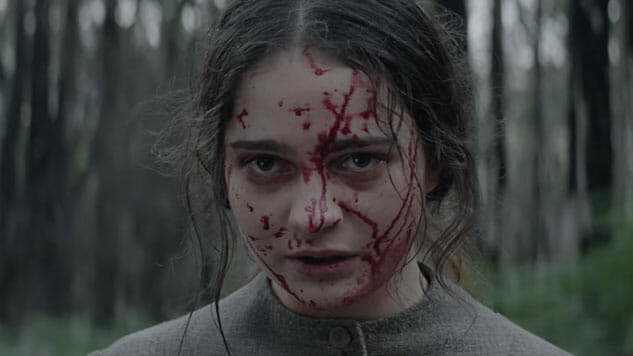The Nightingale

Calling The Nightingale a revenge film sets an expectation of triumph, found in the satisfaction of grim justice done on the unjust. Let it be known that there’s no such catharsis in Jennifer Kent’s followup to her 2014 debut The Babadook. Revenge, while indeed a dish best served cold, tends to be prepared in one of two ways in cinema: with fist-pumping vigor or soul-corroding sobriety. The Nightingale sticks with the recipe for the latter.
This is neither a pleasant movie nor a pleasing movie, but it is made with high aesthetic value to offset its unrelenting pitilessness: It’s fastidiously constructed, as one should expect from a director of Kent’s talent, and ferociously acted by her leading trio of Aisling Franciosi, Baykali Ganambarr and Sam Claflin, respectively playing an Irish convict driven by rage, an Aboriginal tracker driven by vengeance and a British military officer driven by cold ambition and bottomless malice. They’re three peas in a horrible pod, being 1820s Tasmania during the Black War, when English colonists slaughtered Aboriginal Tasmanians to the latter’s near extinction. It’s an altogether dark time in the country’s long history.
Thus, The Nightingale is an appropriately dark film. Clare (Franciosi) serves out a seven-year sentence under her master, Hawkins (Claflin), who’s also her rapist. He refuses to release her from his charge. When Clare’s husband, Aidan (Michael Sheasby), gets involved in her emancipation efforts, Hawkins instigates a scuffle that leaves Aidan and their baby dead. Clare survives. The law declines her entreaties for justice, so she takes justice into her own hands and hires Billy (Ganambarr) to help her intercept Hawkins on the road north for a promotion. Because The Nightingale is an honest film, Clare, low as she is on the social totem pole, treats Billy like garbage. She may be sub-human, but she’s more human, or at least less sub-human, than him.
She’s wrong, of course, but that’s part of Kent’s thesis. The Nightingale doesn’t soft-shoe the trickle-down function of white supremacy, but it does single out whiteness exactly as the social construct that authors like Ta-Nehisi Coates know it to be. Frankly, the film owes a perhaps unintended debt to Coates’ Between the World and Me, an epistolary novel in which he muses that even the Irish were once considered “black.” The trick is that Billy is black, and Clare benefits enough from her whiteness to regard him as a servant—that is, until they share with one another their war wounds over a fire on the hunt for Hawkins. They sing and speak in their mother tongues, and presto, their relationship changes. Ice thaws. Hatred cools. Bonds over their mutual oppression are forged.
-

-

-

-

-

-

-

-

-

-

-

-

-

-

-

-

-

-

-

-

-

-

-

-

-

-

-

-

-

-

-

-

-

-

-

-

-

-

-

-








































